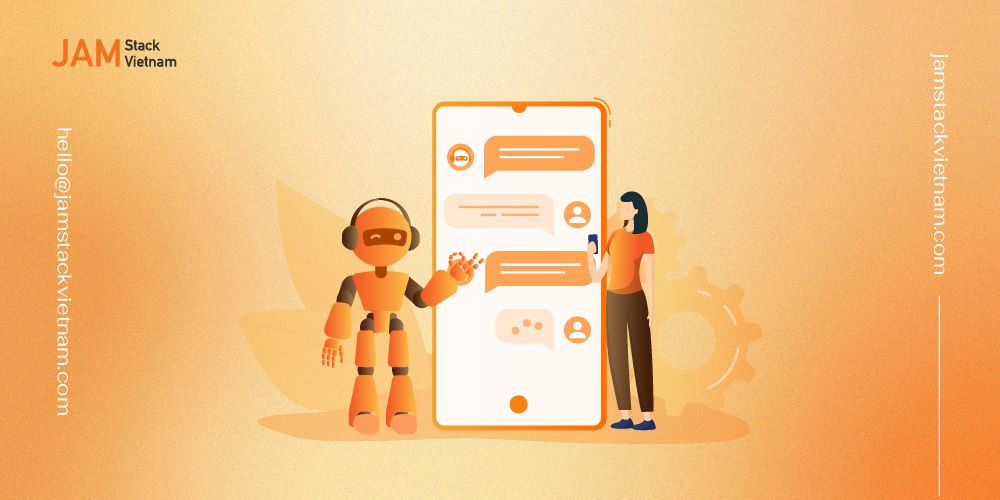Trusted digital product growth partner
JAMstack Vietnam's Capabilities
DIGITAL PRODUCT
DEVELOPMENT SERVICE

- Human Resource Management
- Financial Management, Auditing
- Process Management
- Infrastructure and Warehouse Management

- Sales Management
- Customer Management
- Automated Marketing
- Data Analytics

Our success story

ĐẤU GIÁ TRƯỜNG SƠN: HÀNH TRÌNH CHUYỂN ĐỔI SỐ CỦA DOANH NGHIỆP TRUYỀN THỐNG

iOdds: Nền tảng dữ liệu thống kê chỉ số thể thao lớn nhất thế giới

Our working
process
JAMstack Vietnam values listening to deeply understand the client's business operations. Only when we comprehend the context can we propose suitable solutions, contributing to the value chain that drives sustainable business growth.
Aside from online consulting, JAMstack Vietnam conducts on-site surveys of infrastructure, diving into the practical workflows of the business. We put ourselves in the client's shoes, understanding strengths and gaps in operations and businesses.
Based on our profound understanding of the client, we analyze and evaluate multiple aspects: market, resources, business model and development direction. From there, we propose strategies and concrete roadmaps to develop digital products effectively.
This is the most important stage that determines what digital products that the business should implement to solve current challenges or expand future business opportunities.
Based on our recommendations, we assist businesses in building an effective approach to successfully develop digital products. Goals, resources and action plans will be clearly defined at this stage.
First, we build an MVP (Minimum Viable Product) - a product demo with core features - to test assumptions about market demand and confirm the chosen technology can be practically implemented.
Next, we create a PoC (Proof of Concept) - a prototype or pilot to demonstrate how the product will work.
After the client approves the MVP and PoC, we upgrade them into the official Commercial Product.
Concurrently, we send specialists to support deployment and provide operating training so that the client can confidently and optimally run the product themselves. Details:
- Guide system installation and configuration
- Detailed product usage and operation training
- Support resolving arising issues
- Technology transfer and full documentation hand-off
To maximize the product's business value and effectiveness, we remain engaged throughout its lifecycle:
- Monitor system status
- Periodically evaluate product performance
- Listen to feedback and review improvements
- Propose product upgrade solutions
- Deploy periodic maintenance
The following article will explore the process of developing digital products at JAMstack Vietnam, providing an overview of the benefits it brings and how it can promote sustainable business growth.
1. Understanding Digital Product Development Solutions
Digital products, or digital goods, are products created or delivered as electronic files or code rather than physical items that can be touched. These products exist as digital data and can be accessed, viewed, or used through digital devices such as computers, mobile phones, tablets, or other electronic devices.
Digital products can include items such as ebooks, digital music, films, videos, games, digital photos, or enterprise resource planning (ERP) software used in businesses.
For businesses, products like ERP software, revenue management applications significantly contribute to the overall development of an organization, helping streamline operations effectively, contributing to business access to market digital transformation trends.
To effectively develop products, businesses need to invest in technology, market research, and develop skills and knowledge in digital product management. At the same time, it is essential to consider factors such as intellectual property protection, compliance with security and privacy regulations, and providing support and services to users...

2. Seven-step Process of Digital Product Development
Although there are various approaches, understanding the most crucial elements of a product development process is essential. Here are the 7 key steps in the product development process at JAMstack Vietnam:
2.1 Analysis and Planning
When a client or stakeholder requests a project, the first step in the Software Development Process is planning. This typically involves:
-
Structuring: Ensuring the final product aligns with the business’s goals and mission.
-
Resource allocation: Determining the workload and personnel required for project implementation.
-
Project planning: Establishing a plan and expected timeline for the project.
-
Cost estimation: Assessing projected investments and related costs.
The planning phase is the initial but crucial step in software development. It requires the involvement of relevant departments such as Product Owner, Project Manager, Business Analyst, and CTO. The time spent on planning and analysis may vary depending on the project. However, meticulous execution of this phase is necessary to ensure project success and prevent disputes over the product.
2.2 Requirements Identification and Ideation
In this stage, requirements analysts closely interact with clients or stakeholders to better understand the project's specific needs. Meetings, discussions, and related documents are used to gather information on functionalities, user interfaces, performance, and other technical requirements.
Requirements need to be categorized and prioritized to ensure that the project's most critical goals are prioritized. Additionally, clear standards and regulations that the project needs to adhere to must be identified.
Once requirements are defined, the development team proceeds to brainstorm ideas on how to implement the project. This may involve selecting appropriate technologies, building system architectures, and designing user experiences.
Discussions and collaboration among team members are crucial during this stage. The goal is to create a comprehensive idea that aligns with the identified requirements, ensuring project feasibility and effectiveness.
2.3 Prototyping
After requirements are identified and ideas are generated, the next stage in the software development process is prototyping. This is a preliminary test version of the application or system created by the development team to provide a clearer view of how the project operates and its interface.

During this stage, the design team starts building the user interface (UI) based on previously identified requirements and ideas. Using design tools and techniques, they create pages, UI components, and interaction flows that users will encounter when using the application.
Prototypes need to provide basic features to simulate how the application operates. These features typically focus on key elements that the application will provide to end users.
2.4 Detailed Design
Once the preliminary prototype is completed, the next stage is detailed design or application design. This is a critical stage in the digital product development process, where initial abstract concepts and ideas are transformed into specific designs ready for deployment and programming.
Specific activities in this stage include:
-
User Interface (UI) design: Here, the design team focuses on creating the final user interfaces with specific components such as buttons, input fields, menus, etc. UI design ensures optimal visualization for user experience.
-
User Experience (UX) design: UX design focuses on ensuring that the application operates smoothly and users can interact with it easily and naturally.
-
Creating images, charts, and graphics: The design team creates necessary images, charts, and graphics to decorate and provide visual information within the application.
-
Identifying interaction elements: This stage involves defining interaction elements such as hover effects, animations, and other interactive functions to optimize user experience.
2.5 Testing
At this stage, you engage in the final confirmation process for your product idea. One of the best ways to ensure usability is to test the software and observe how people interact with the interface and provide feedback on the product.
Additionally, you may participate in internal testing, where you ask users to guide you through using the product in their own way. The goal here is to provide testers with independence and see how they use your solution.
After completing the testing step, the development team collects feedback from stakeholders, including both customers and team members. This feedback helps improve the prototype and prepares for actual development.
2.6 Development
This stage involves the participation of programmers, where initial ideas and designs are translated into the final product. The development team analyzes the concepts and designs identified from the previous stage. They delve into specific requirements, functionalities, and user interfaces. Based on this information, they create a detailed plan on how to implement the digital product.
Programmers write code to build the software according to the specifications outlined in the design phase. They ensure that the application functions as intended, handles user inputs correctly, and delivers the expected outputs. Collaboration among team members is crucial during development to address any issues that may arise and to ensure the product meets quality standards.
2.7 Maintenance and Updates
Finally, the product is completed and enters into the operation and management phase of the business. However, even after deployment, it requires regular monitoring, maintenance, and updates from the technical team to remain effective and adapt to each stage of the business's development. Throughout its use, the company can analyze statistics based on real-time operations and continuously improve its product.
By following these seven steps in the digital product development process, JAMstack Vietnam ensures that each project is meticulously planned, designed, tested, and implemented to meet the specific needs and expectations of its clients. This structured approach helps in delivering high-quality digital solutions that drive business growth and innovation.
3. Building an Effective Digital Product Development Strategy
To build a product that meets a business's needs effectively, having a development strategy is crucial. Here are four key considerations when planning to develop a digital product for your enterprise:
3.1 Identify the Problem Your Business Wants to Solve
First and foremost, to develop an effective strategy, it's essential to clearly define the problem your business aims to solve. This may involve analyzing needs, gathering feedback, or researching specific issues the product will address. Clearly identifying the problem helps set the direction and specific goals.

3.2 Understand How Your Business Will Address That Problem
Once the problem to be solved is identified, the business needs to determine how to approach and effectively solve this issue. This could involve researching and applying technological solutions, improving operational processes, or developing supporting services. Having a specific direction helps efficiently tackle the problem.
3.3 Visualize the Product
Visualization of the product, including prototyping and detailed design, plays a crucial role in the product development process due to its many important benefits.
Prototyping and detailed design help to clearly define how the product will function and its interface. They also enable the testing team to evaluate and provide feedback on feasibility and user experience early in the process. Design prototypes are easier to adjust and modify compared to later stages of formal development, saving time and effort.
Moreover, visualizing the product creates a common ground for team members to discuss, provide feedback, and make decisions based on specific objectives. Providing a clear view helps everyone understand how the product will operate and deliver specific benefits.
3.4 Continuously Optimize the Product
Continuous optimization is an indispensable part of the product development process. It's a continuous process that demands commitment and focus from the development team. There are several crucial reasons why this is extremely important:
Firstly, it allows for quick adaptation to market changes and business needs.
Secondly, it provides an opportunity to improve user experience by collecting and analyzing feedback from users.
Furthermore, optimizing the product enhances its performance and efficiency.
Lastly, delivering a product that is consistently updated and improved helps maintain and expand its relevance.
By focusing on these four aspects in developing a digital product strategy, businesses can ensure they are building solutions that are not only effective but also adaptive to evolving market conditions and user expectations.
4. 3 Major Challenges in Digital Product Development and Solutions
Developing and designing a product can pose numerous challenges, which is natural. However, the key is to identify these challenges and find solutions to address them. Here are the three most common challenges developers often encounter:
4.1 Identifying the Business Pain Points
Firstly, identifying the issues within a business can be a challenge that development teams face when building a product. The product's goal should revolve around meeting user needs.
While this might seem obvious, many companies do the opposite by conducting research after launching, which not only counteracts but also incurs significant costs. Product testing should occur during development and continuously during operation so that businesses can understand the market and optimize digital products to suit each stage of development.
4.2 Determining Investment Costs
Balancing current product requirements with long-term business goals is a difficult point for both development teams and businesses.
Deciding how much to invest in initial product development to meet long-term objectives without waste is crucial. To balance appropriate investment costs, market research, complete prototyping, and thorough testing based on business usage needs should not be overlooked.
4.3 Continuous Adjustment of Product Needs
Continuously optimizing digital products, even after deployment, is an essential step. However, during upgrades, projects can generate new features or product demands. While you may be tempted to skip these and stick closely to the initial plan, we advise against it.
It's important to recognize that the design process, although tightly organized, also comes with unexpected issues unlike those in the initial project. As long as the improved product meets the best business needs.
5. JAMstack Vietnam Offers Specialized Digital Product Development Services for Businesses
5.1 Introduction to JAMstack Vietnam and Service Offerings:
JAMstack Vietnam is a company specializing in professional consulting, website development, software development, and digital marketing services. With years of industry experience, we are proud to have earned the trust of prominent brands such as Rạng Đông, Apollo Silicone, Á Đông ADG, Money Forward Vietnam, Bernard Healthcare, PCS Vietnam, TSA, and more, becoming their key partners.
Our digital product development services provide comprehensive solutions aimed at driving business growth through digital marketing and communication activities.
With practical experience across various fields and an exceptional team of experts, we confidently deliver optimized solutions for businesses, ranging from customized business management applications, enterprise resource planning (ERP) systems, to financial management software.
Furthermore, by leveraging cutting-edge development technologies, businesses choosing JAMstack Vietnam's services can maximize their product potential to achieve their goals effectively.

5.2 Advantages of Choosing Digital Product Development Services:
Experienced Consulting Team: JAMstack Vietnam boasts a team of highly experienced experts who have worked on numerous projects, including business management app development, comprehensive business management software, digital transformation consulting, and ERP systems. This ensures that businesses receive the best possible consultation and support.
Close Collaboration with Businesses: We are committed to closely accompanying businesses throughout the digital product development process. We respect business opinions and are always ready to listen to and fulfill their requirements.
Application of Modern Development Technologies: JAMstack Vietnam leads in applying the latest and most advanced development technologies worldwide in its work processes. This ensures that businesses' products remain resilient in the face of technological challenges.
Dedicated Customer Support Team: We prioritize building long-term relationships with our customers. Our customer support team is dedicated to assisting and addressing any inquiries from businesses attentively and thoroughly.
6. Conclusion
When your esteemed business chooses JAMstack Vietnam for digital product development services, we commit to delivering professionalism and meticulousness in every stage of the development process, aiming to provide the highest quality, most optimized products aligned with your business goals. With our deeply experienced technology experts, dedication, and ability to meet diverse customer requirements, we are a reliable partner for your business.
We look forward to collaborating with you to turn ideas into reality through product development.
Contact us now for expert advice on digital product development services.



